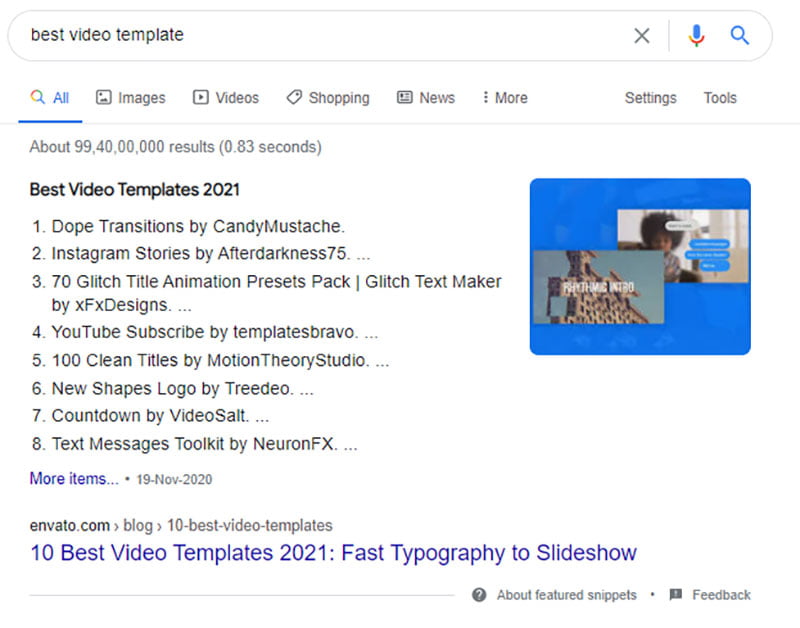In this post we are going to cover exactly what you need to do to market your infographics, drive traffic and links to them.
Let’s get started with the step-by-step process for you to follow:
Optimize Your Infographic for SEO
Table of Contents
You can optimize infographics for SEO. This is another way of saying you can optimize images for SEO.
There are steps needed to make this possible.
Do keyword research
Getting started with keyword research is easy. Choose a primary keyword you want to base the infographic on. The process is similar to what you’d normally do when optimizing a blog post for SEO.
If you’re creating an infographic on say best video templates, you need to know what people are searching around video templates.
The first thing you will see is a featured snippet. Google uses featured snippets to show answers to the most popular questions around the particular term.


So in some cases the search engine giant simply picks up the most popular question like what are video templates. Here in this case they’re featuring a site listing 10 popular templates.
Scroll a little below and you may also find a section called “People also ask”. This gets you a number of popular questions that the target audience is interested in.
Copy paste these keywords to a spreadsheet and then enter these keywords into a keyword research tool like Ahrefs or SEMrush.
You get the exact monthly search volume for each keyword and it also highlights related keywords and similar search terms as well.
This gives you a big list of relevant keywords you can use for optimizing your infographics and also ideas to search for and source relevant information to create the infographic on. If you initially thought of covering certain topics keyword research might help you validate your idea. It may point out to something else that’s popular. Perhaps you should go for those keywords.
Keyword research helps you form the basis of how you’re going to create a meaningful structure for your readers.
Choose a meaningful file name
Google cannot directly read the content of images. So they rely on meta data like the file name, the meta description and tags to understand what the image is about.
A file name that goes IMG2222229999.png isn’t helpful, neither to the reader nor to a search engine.
The best thing to do is choose a meaningful name and separate words in it through hyphens so that the Googlebot can read it sequentially.
Here’s an example: Visual-templates-their-role-in-marketing
Always include the primary target keyword in the file name.
Optimize the alt text
Alt text is another area to optimize. If the image doesn’t load, the alt text provides people context on what the missing image was about. Search engines read alt text to understand what the image contains.
Add the main keyword to your URL
We should use every chance we get to optimize for SEO. One good SEO practice is keeping URLs short. Ideally the url shouldn’t be longer than 3 to 5 words.
So it could be something like example.com/video-templates
Include your target keywords or the primary keyword for the highest SEO impact.
Optimize the meta description
The meta description is the introduction of the infographic to search engines. Also, Google picks up the meta descriptions to display in search. So readers too should find it appealing. The meta description summarizes what the infographic is and who’s it for.
Like any introduction stay to a character limit:
- The general rule is to keep the meta description under 160 characters.
- Include the target keywords for SEO
Submitting to Infographic Directories
There are plenty of online directories available where you can submit your infographic to. This results in increased traffic and generates a lot of feedback for your content.
Submitting to infographic directories is the easiest tactic to get both links and traffic back to your site.
To get you started, here are some of the most popular infographic directories that accept submissions:
- ly
- Slideshare
- Fast Company
- Infographics Showcase
- Flickr
- Infographic Bee.
Blogger Outreach for Infographics
To reach a wide audience— partnering with bloggers and influencers almost always works. Make a list of relevant bloggers and influencers and then demonstrate why your infographic will add value to their audience. You can use one of these proposal templates.
Bloggers are always on the hunt for highly relevant content to share with their audience. One such content is infographics.
The topic of the infographic should interest the audience. To understand this do a keyword research with the domain to see if similar topics were covered in the past.
Next contact the webmasters of these sites and how you came across their articles and tell them what you liked about what they wrote and then pitch them your idea of an infographic.
With this, your email pitch doesn’t come across as an aggressive request for a backlink but rather an attempt to share an interesting visual you created.
You can also add a guest post along with the infographic because that’s more value.
Guestographics are infographics where you get a mention to your site as a credit.
Quicksprout used this tactic to grow their blog. They created interesting infographics for each of their landing pages and also for their blog posts. If you don’t have the time for outreach you can outsource the task to a freelancer on these freelance sites.
Whenever people embed these links on their site you get a link back to your site. Venngage has grown traffic and revenue with the help of guestographics. It’s a tactic that worked for them. If it worked for them, it can work for you too.
Pitch bloggers infographics along with exclusive supporting copy so that it adds more value.
Next, ask them to share the infographic across their social media platforms
An insight filled infographic that looks great to the eye created free of cost is a win-win for both parties. The more links you build, the more money you make.
Send an Email to Your Email List
Your mailing list is another good spot to market your infographics. Send them a mailer with a thumbnail picture of the infographic with a link to your landing page.
That’s the best way to get people to your infographic. Additionally embed social media sharing buttons on the infographic landing page so that it gets shared more and reaches more people.
Use Social Media to Promote Infographics
Sharing infographics on social media is another way to get the party started.
When planning a social media promotion the first thing you need is choosing the right channels. The second thing is focus. Think of platforms that are going to get you the biggest engagement and start working from there.
Instagram and Pinterest are great places to start sharing images. LinkedIn isn’t thought to be as powerful but is a potential place for infographics because the platform hasn’t killed organic shares and reach.
When you share your infographics on social media, include a thumbnail image and link back to your landing page. Both the infographic and the landing page should be aptly designed following current design trends.
Different social media platforms set different image sizes.
So each thumbnail needs to fit those requirements depending on where you are sharing your infographics.
The next thing to keep in mind is that when promoting on Twitter or on Instagram choose the most apt hashtags.
SlideShare is another good platform to share parts of your infographic sliced in a manner to form a full presentation. If you wish to convey the infographic as a presentation it’s best to know the designer ahead.
Marketing strategies like making and distributing infographics helps people respect your expertise and trust your brand as a whole. It helps conversions.
Research shows that 73% of content creators want to create more engaging content. 55% want to create more visual content. In addition to sharing visuals on social media you can also share custom QR codes leading back to your site’s landing page.
As long as you provide genuine value to the audience it can be a great asset.
Market Expert Roundups with Infographics
A few years ago, expert roundups used to be really popular.
Then everyone started publishing expert roundups and its popularity fell off a cliff.
But, expert roundups are a content format where infographics can still shine.
Expert roundups are powerful in the sense that it helps you build relationships with influencers. It increases the number of social shares for the content and saves time creating content.
experts contribute the bulk of the content to your roundup article.
Concluding thoughts
You may have never thought of infographics and SEO going hand-in-hand. The truth is, SEO is quite important to helping market infographics.
In the same way, reaching out to bloggers and influencers is another critical aspect of marketing your infographics. You build links to your site that way.
So what do you think of the tips and tricks outlined here to market your infographics. Do let us know in the comments below.
Author bio: George is a writer and blogger at Kamayobloggers and ThinkingNE, two sites he started to share cutting edge marketing insights online. He has over 9 years of experience writing online.





